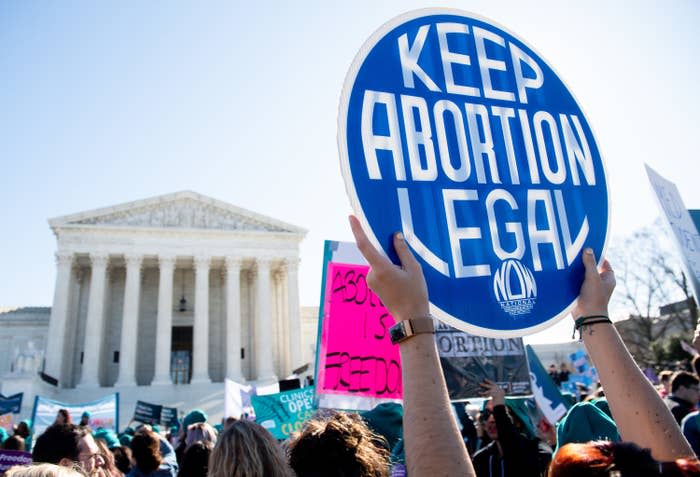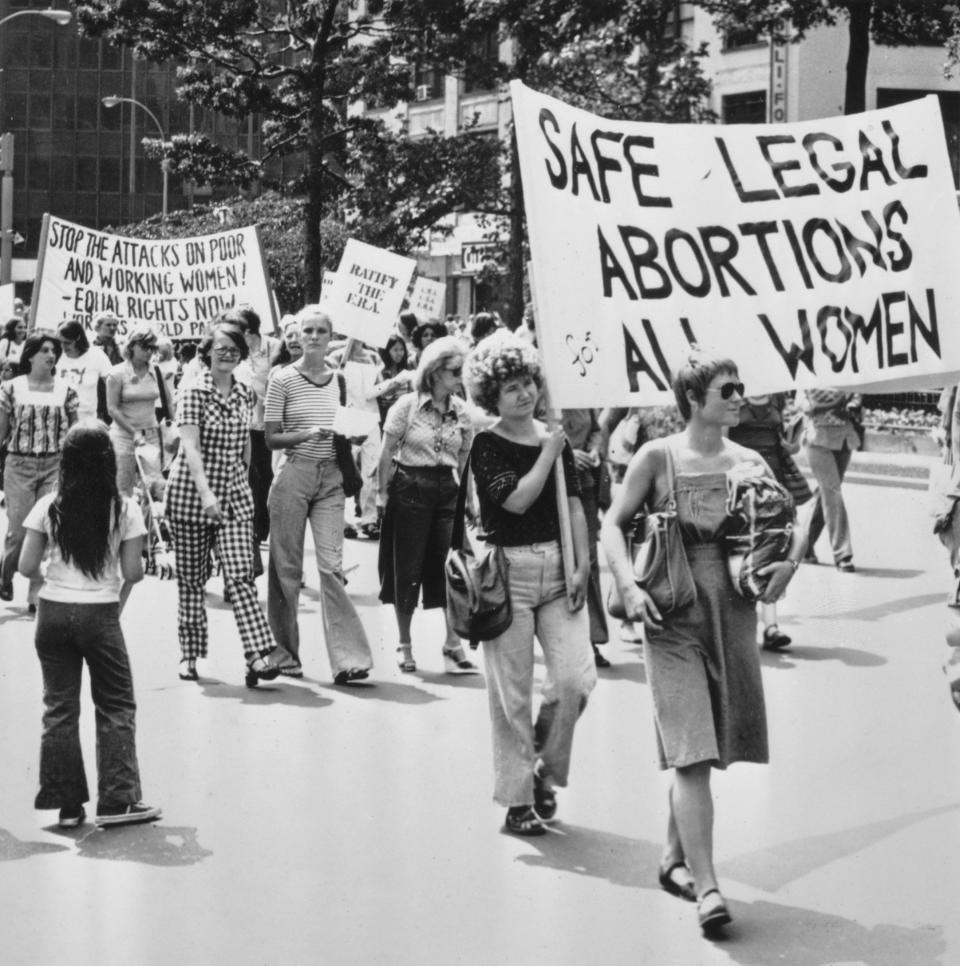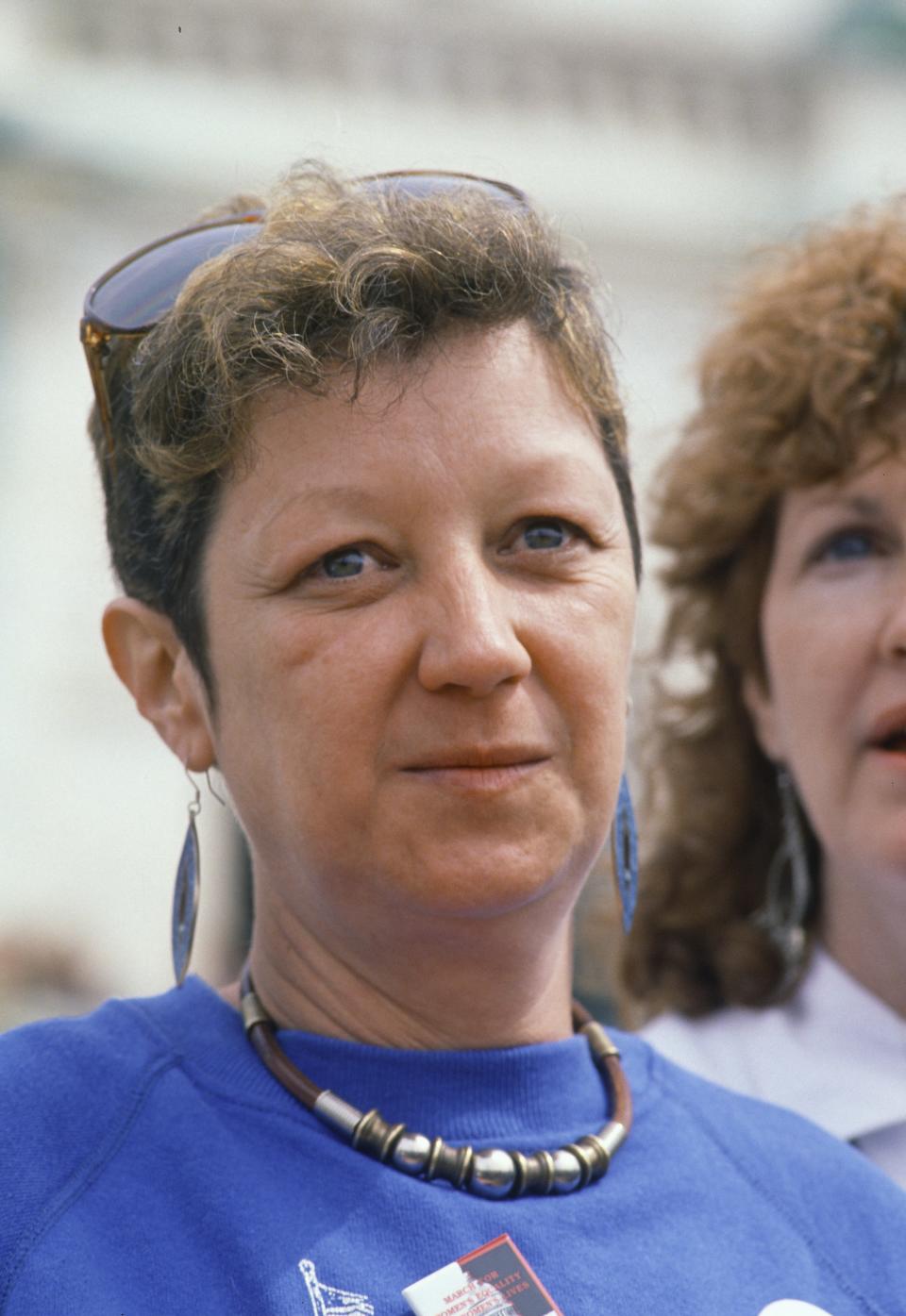This OBGYN Went Viral For Explaining What Would Happen If Roe V. Wade Is Overturned, And It's Incredibly Eye-Opening
January 22, 2022 marked the 49th anniversary of Roe v. Wade, and many fear that it could be the case's last before its overturned. In 2021, states enacted at least 106 abortion restrictions, marking a record for the most restrictions passed in a single year since Roe v. Wade was decided in 1973.

These restrictions include Texas' six-week abortion ban, its seven-week abortion pill ban, and Mississippi's 15-week abortion ban.
To note, Roe v. Wade was a landmark Supreme Court decision that ruled that the US Constitution protects a pregnant person's right to abortion without excessive government restriction. Overturning the ruling would not automatically ban abortions in the US. Instead, without federal protection, the right to abortion would be independently decided by each state.
Dr. Jennifer Lincoln (@drjenniferlincoln), an OB/GYN, went viral when she addressed the potential ramifications of overturning 'Roe' in a video on TikTok — that amassed nearly 2 million views and more than 6,000 comments — outlining "five terrible things that will happen when 'Roe v. Wade' is overturned."
@drjenniferlincoln 5 (terrible) things that will happen when #roevwade is overturned. #supremecourt #bansoffourbodies #dobbsvjackson #obgyn #newsupdate #todayilearned
♬ News Headlines BGM(1075079) - ArcTracks
She prefaces the video with, "It doesn’t mean that we can’t still protect abortion, that’s the topic for another day, it just means we can’t rely on the Supreme Court," before going on to list the following five things:
• Twenty-six states will likely or very likely ban abortion immediately. Twenty-one states already have those laws in place.
• In those 26 states, 36 million people with uteruses of reproductive age will not be able to access legal abortion.
• Driving distances for safe and legal abortions will dramatically increase. For example, some who lives in Florida would have to drive 575 miles one way to access legal abortion.
• More pregnant people will be exposed to domestic violence/abuse in their households. Because they are pregnant, they are less likely to leave their partners.
• Poverty for people with uteruses will worsen. Studies show that people who were denied an abortion and carry an unwanted pregnancy to term have four times greater odds of living below the Federal Poverty Level (FPL).
To speak more deeply about the potential ramifications of overturning Roe v. Wade, BuzzFeed reached out to Dr. Lincoln, an obstetrician and the author of Let's Talk About Down There. "My colleagues are truly disturbed to see the rights of our patients being taken away and to see the patient-doctor relationship be eroded and invaded by government regulation," Dr. Lincoln shared. "You can scroll through my TikTok comments section and see how many people living in Texas and other restrictive states are so scared to see their autonomy being taken away — to the point where they are looking into getting an IUD or stocking up on emergency contraception."
While abortion would still be legally protected in certain states if Roe were overturned, Dr. Lincoln pointed out the lack of equity this would result in, wherein only those with the means to travel to states with legalized abortion could obtain one. "This is not fair or equitable — that access to basic healthcare depends on your zip code. Pregnant people should have equal access to reproductive care no matter where they live, and this is why federal legislation is so needed," she asserted.
In addition to her five points, Dr. Lincoln recognized that criminalizing abortion would lead to a rise in unsafe abortions and deaths in pregnant people. Moreover, it would disproportionately affect traditionally underserved communities, such as BIPOC and low-income communities. Criminalizing abortion would also not prevent abortions, only make them less accessible. "Illegal abortion will look a lot like what it did in the pre-Roe era," Dr. Lincoln specified.

"I also think we will see a lot more people attempting medication abortions on their own," she mentioned.
Deaths of pregnant people would also increase in part because, as Dr. Lincoln cited, legal abortion is safer than childbirth, with complications being extremely rare. In 2019, the US maternal mortality rate was 20 maternal deaths per 100,000 live births. In contrast, there are 0.7 maternal deaths per 100,000 legal induced abortions. As for illegal abortions, there are 30 maternal deaths per 100,000 illegal induced abortions in developed nations. Additionally, Dr. Lincoln stated that illegal abortions are associated with higher rates of infections, sepsis, and hemorrhage, and higher needs for hospitalization and hysterectomies.
Speaking of hysterectomies, many commenters talked about wanting ones should their right to abortion be denied. Some then brought up that people with uteruses still typically require a "husband's" or even "future husband's" permission to obtain a hysterectomy. While Dr. Lincoln understands such drastic measures, she believes people would likely seek out more reliable contraception instead.

Reliable contraception includes IUDs and arm implants.
And though there's nothing wrong with seeking out reliable contraception, Dr. Lincoln emphasized, "The problem is that, in these states, access to and coverage of family planning services can be harder to come by (ironically). I do worry that more people may consider tubal ligations or hysterectomies to ensure they don't get pregnant now but, down the road, may want children. They should not be so afraid of pregnancy that they feel pushed to this, but this is what happens when you have excessive government uterine regulation."
To better understand what would be overturned and subsequent ramifications, let's talk about Roe v. Wade itself and the surrounding social climate for a minute. In 1968, 21-year-old Dallas woman Norma McCorvey — "Jane Roe" — was pregnant for the third time. She had given up her first two children and did not want to bring a third pregnancy to term. McCorvey's adoption lawyer referred her to attorneys Linda Coffee and Sarah Weddington, and in 1970, they filed a lawsuit against Dallas County district attorney Henry Wade. A Texas district court unanimously ruled that the anti-abortion law violated the constitutional right to privacy but declined to grant an injunction. Both parties appealed, resulting in Roe v. Wade reaching the Supreme Court later that year.

McCorvey's mother primarily raised her first child, while her second was placed for adoption. About McCorvey, a Washington Post article describes, "McCorvey strung together low-paying jobs in Texas and at various points struggled with substance abuse; she wasn’t prepared to become a parent."
The article continues, "McCorvey's life had been hard. Her mother hit her. As a girl, she ran away with a female friend, and when they were caught kissing, she was sent to reform school for punishment. She escaped a marriage to a man who she said abused her and found a long-term partner in Connie Gonzales, but the 1970s and '80s weren’t always welcoming times for lesbians."
Essentially, McCorvey was a well-suited plaintiff for the lawsuit because her socioeconomic circumstances were such that she could not afford to travel to a state with legalized abortion, so her attorneys could make the case that "the current state-by-state solution placed an impossible burden on their client."
However, in spite of the district court's ruling in favor of "Roe" and due to its lack of injunction, Wade immediately declared that he would continue to prosecute physicians who provided abortion services.
At the time, abortion was legal in five states and illegal in 30 states without exception. The remaining 15 states prohibited it, as well, but had varying exceptions in cases of rape, health threats, etc. While some Americans could obtain safe, legal abortions by traveling out-of-state (or country) or by paying large sums for a secret, illegal abortion, McCorvey did not have the financial means to do so — and she wasn't the only one. "Back-alley" or self-induced abortions (both illegal and dangerous) were not uncommon at the time. Between 200,000 and 1.2 million illegal abortions took place every year in the 1950s and 1960s, as estimated by the Guttmacher Institute.

In the US, abortion was legal up until 1821, when the first abortion law appeared. Between the 1860s and 1880s, abortion was outlawed state-by-state. In 1971, abortion was legally available in only Washington, DC, and five states: Alaska, California, Washington, Hawaii, and New York. While 87% of the 480,259 reported legal abortions that year were performed in these five states and DC, 84% of all (known) abortions obtained out-of-state were performed in New York.
New York legalized abortion within 24 weeks of pregnancy in 1970 and soon became — as Democratic assemblyman Franz S. Leichter, who wrote the New York bill, phrased — "the abortion clinic for the whole nation." Ads in magazines, on billboards, and even on matchbook covers announced opportunities for abortions in New York.

In an interview with the New York Times, retired OBYGN Dr. Carmel J. Cohen, who practiced at Mount Sinai Medical Center in New York for more than 60 years, said that "the overwhelming majority of his abortion patients in the early 1970s had traveled from outside the state," and patients "with the financial means would often travel to and from New York for an abortion in a single day."
In 1972, out-of-state individuals accounted for 60% of the 118,000 abortions performed in Manhattan. After Roe v. Wade enabled people to obtain abortions in their own states in 1973, many Manhattan abortion clinics faced financial trouble without out-of-state patients. However, thanks to Roe, the distance people had to travel to access abortions significantly decreased.
In 1973, the Supreme Court ruled in favor of "Jane Roe" in a 7-2 decision, striking down the Texas law and federally legalizing abortion. The court declared that the state's anti-abortion law violated the Due Process Clause of the 14th Amendment, which essentially protects one's right to privacy against state action. This constitutional right to privacy, the court held, encompassed one's qualified right to terminate their pregnancy. However, the court also supported governments' interest in protecting one's health and prenatal life. To balance these, the court broke pregnancy into three trimesters: In the first trimester, state governments could not prohibit abortion. In the second trimester, state governments could regulate but not ban abortion. In the third trimester, state governments could prohibit abortion to protect a fetus unless the person's health is in danger.

Two justices dissented from the court's decision. Justice White argued — as expressed in Roe's companion case — Doe v. Bolton, that the Constitution does not support the court's decision's to value the "convenience of the pregnant mother more than the continued existence and development of the life or potential life she carries," and, as such, the court overstepped by "[announcing] a new constitutional right for pregnant mothers." Rather, he believed that the decision should be left to states and their respective people and legislatures.
Justice Rehnquist argued that abortions performed by licensed physicians on clients are not considered "private," and that the 14th Amendment intended the right to "privacy" to mean freedom from unreasonable searches and seizures. Otherwise, the term "privacy" could then be claimed by any person who wanted "to be free from unwanted state regulation of consensual transactions."
He further argued that the 14th Amendment does not grant a right to abortion because "by the time of the adoption of the Fourteenth Amendment in 1868, there were at least 36 laws enacted by state or territorial legislatures limiting abortion." Therefore, it was never intended to protect the right to privacy (beyond unreasonable searches and seizures), let alone one's right to abortion.

As for McCorvey herself, she never had an abortion. By the time of the Supreme Court's decision, she had already carried out her pregnancy, and the child had been adopted. She continued to support abortion rights until the mid-1990s when she was publicly baptized before spending the next two decades as part of the pro-life movement and renouncing being a lesbian (though she continued to live with her partner).
However, in the 2020 documentary AKA Jane Roe, McCorvey, who died in 2017, said she had never changed her mind: "I was the big fish. I think it was a mutual thing. I took [anti-abortion group's] money and they put me out in front of the camera and told me what to say, and that’s what I’d say. If a young woman wants to have an abortion, that's no skin off my ass. That’s why they call it choice."
To many, the pre-Roe v. Wade era mirrors a future era with Roe overturned — one in which, as Dr. Lincoln outlined, tens of millions of people with uteruses would be unable to access safe and legal abortion without substantial financial means. Instead, they would have to travel unnecessarily long distances and likely live in worsened poverty. Further, more pregnant people would likely be exposed and subjected to domestic violence as they'd be less likely to leave their partners (and have lesser means to while pregnant or with a child). Because overturning Roe would allow states to independently regulate abortion rights, one way to impact abortion rights in your state is by voting locally.

• For general voting resources, see: Vote411, USA.gov, Rock the Vote, Vote.org, and EAC Resources for Voters.
• To learn about some acts and measures being taken to protect abortion access, see: the Women’s Health Protection Act, the EACH Act, and the FDA’s decision to permanently lift restrictions requiring in-person pickups for medication abortions
• For reproductive rights resources, see: #VOTEPROCHOICE, Planned Parenthood's Voting Rights Resources, and the ACLU's Reproductive Freedom breakdown.

